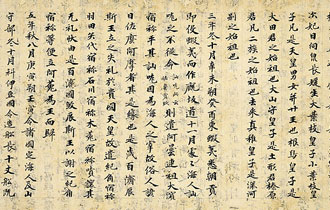Pages |
With the coming of railroads in late nineteenth century, local trains became the chief means of moving the population around within the confines of the city. In particular the Yamanote line, which formed a circle that ranged around the core of the city, served as a means to encourage urban development around the stations constructed at various points along the line.
Our journey might appropriately begin with the Nihonbashi (Japan Bridge) area (print by Hiratsuka), traditionally considered the center of the city, which, during the earlier Edo period, provided the spot from which all distances in the country were measured. That site was long famous because of a celebrated print of Hiroshige. Close by are two other celebrated bridges, Kyōbashi (Capital Bridge) print by Fukazawa Sakuichi and Shinbashi (New Bridge) (print by Hiratsuka).
Slightly to the south is the central Ginza area, located somewhat to the east of the Imperial Palace, itself the subject of a famous Onchi print, Nijūbashi (Double Bridge). This area is well known for such landmarks as the old Tokyo Station, still in use today, and, as mentioned above, the subject of one of Onchi's most celebrated prints. The Kabukiza (Kabuki Theater) is nicely rendered in a print by Fujimori Shizuo. Nearby are the office buildings of Marunouchi and Hibiya, also represented in the set.
Travelling south, the series includes a view by Maekawa Senpan of the area near Shinagawa Station, one of the major transportation hubs of southeast Tokyo, and the not too distant Yanagi Bridge (Willow Bridge) in Ryōgoku, seen in a print by Fukazawa Sakuichi. Some distance north of Shinagawa are the hereditary temples of the Tokugawa family, the hereditary shogun (civil rulers of Japan) from 1600 to 1868, at Zōjoji, a well-known Buddhist temple (print by Fukazawa Sakuichi).
Continuing around the circle and up towards the western part of the city, we next come to Shibuya. In recent years, the area has become extremely fashionable as a shopping and entertainment area, but during the interwar period it still retained its character as a quiet, aristocratic part of the city. The prewar shopping area is depicted in a print by Maekawa Senpan.
Moving still to the northwest, one comes to the area of the famous Meiji Shrine, a huge and beautifully maintained public park dedicated to the Emperor Meiji (1851-1912), the grandfather of Emperor Hirohito, mentioned above. Henmi Takashi added a view of the park's Memorial Picture Gallery to the series.
To the north of this area is Shinjuku, of the busiest and most colorful areas of Tokyo, filled with theaters, restaurants, hotels, and department stores. Two of the printmakers, Maekawa and Fukazawa, chose to depict the central area, while others chose sites nearby.
Going still north and around to the top of the city, we travel to Yotsuya, then to Ueno, an area near the top of the city that at one time housed a number of shrines and other sites related to the Tokugawa family. Ueno is popular now for its pleasant park, seen a print by Hiratsuka Un'ichi, as well as for the Zoo, the museums, and the botanical gardens, also shown in prints from the series.
Pages |











